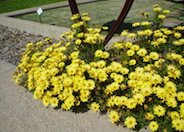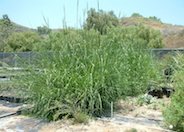
Common name:Pencil Tree, Pencilbush, Milkbush
Botanical name:Euphorbia tirucalli
In frost free areas, Euphorbia can become a 30' tree but in colder areas, it is often knocked back by frost. It can be single or multiple trunked. It has green cylindrical branches that are about the diameter of a pencil. Leaves are not usually present. Some people are allergic to the sap. It is tolerant of salt, full sun, part shade and quite drought resistant. It is a great accent plant for a container. This form has light green branches if in full sun.

Common name:Blue Moor Grass
Botanical name:Sesleria caerulea
This grass will grow to about 18"-24"tall and 18"-24" wide. It has bluish green or gray green leaves.

Common name:Arctotis Daisy, African Daisy
Botanical name:Arctotis hybrids
African Daisy hybrids grow 12"-18" high and 12" wide; they produce daisy-like flowers from spring through summer. These hybrids have lobed leaves and bloom in white, pink, red, purple, cream and orange.

Common name:Giant Wild Rye
Botanical name:Leymus condensatus
This prominent, tall native grass does not make its way into traditional residential landscapes but can be used very effectively in a native or natural garden. It reaches heights of 6'-8' when blooming and will clump to 4'-5' wide. It requires supplemental water to remain green in the summer. Too much water will cause the grass to decline significantly. It can be pruned annually to promote new, more attractive growth. Tall grasses are highly combustible.

Common name:Bird Of Paradise
Botanical name:Strelitzia reginae
This shrub will grow to 6' tall and has large, gray green fronds with orange, blue, white, or multi-colored flowers that bloom throughout the year.
| Designer: Dustin Gimbel | Silverlake Garden 4 |
Photographer: GardenSoft |
Soils and Compost:
Practice grass-cycling by leaving short grass clippings on lawns after mowing, so that nutrients and organic matter are returned to the soil.
Water Saving Tip:
Adjust sprinklers to avoid watering sidewalks and driveways.
Integrated Pest Management:
Drip and other smart irrigation delivers water directly to roots, allowing no excess water for weeds.
